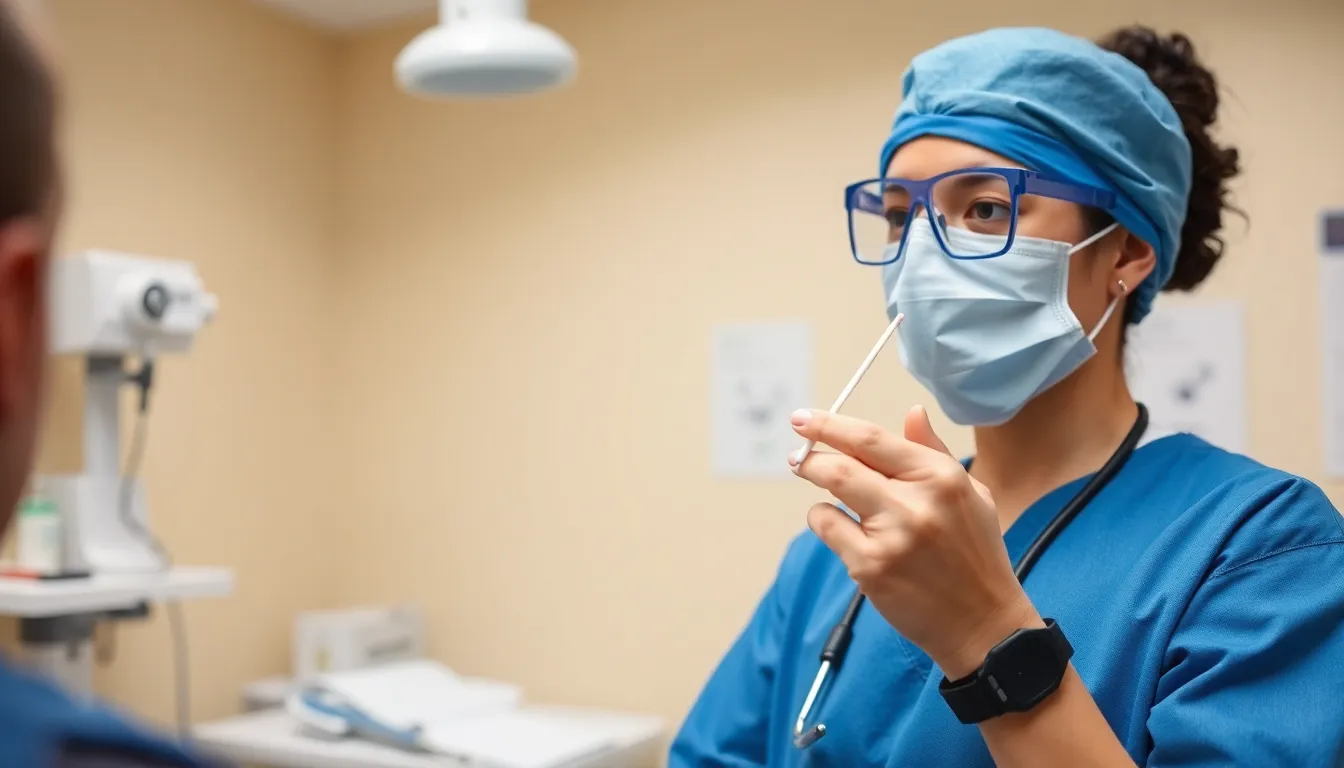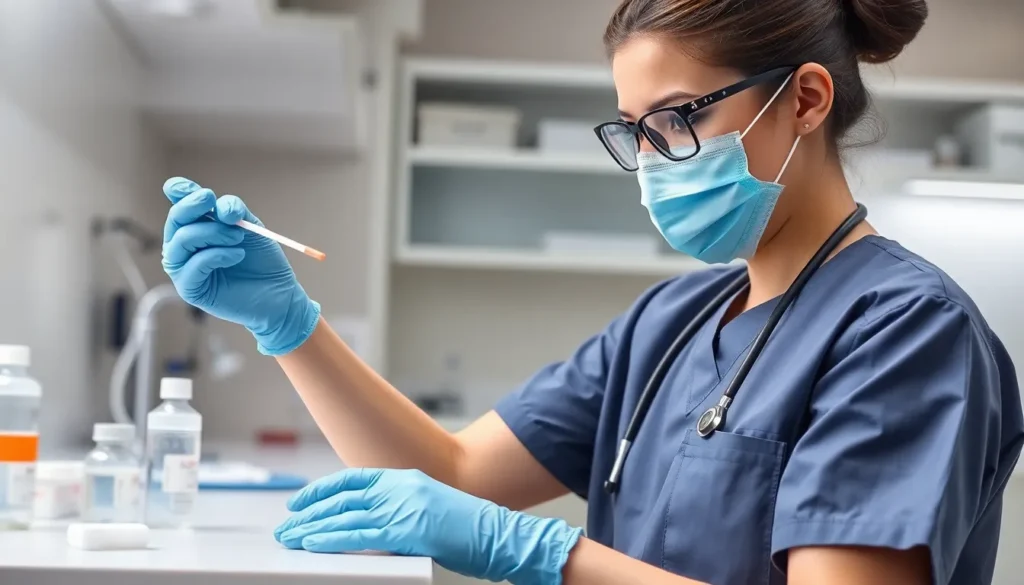In a world where germs are the new celebrities, the viral culture swab takes center stage. This unassuming little tool is the unsung hero of the medical field, stepping in to save the day by identifying those pesky viruses lurking in the shadows. With a quick swab, it captures the bad guys, allowing scientists to unleash their inner detectives and decode the mysteries of viral infections.
Table of Contents
ToggleUnderstanding Viral Culture Swab
Viral culture swabs play a key role in the detection and investigation of viral pathogens. These swabs allow for the collection of samples, facilitating the laboratory analysis of viral infections.
What Is a Viral Culture Swab?
A viral culture swab consists of a sterile applicator with a tip made from a material that promotes viral survival. Typically, this device collects specimen samples from the throat, nasal passage, or other bodily sites. Similar to traditional swabs, it features an adept design that maximizes surface area for better sample collection. Enthusiasts of viral studies utilize these swabs for accurate isolation and identification of viruses in clinical settings.
Importance of Viral Culture Swabs in Medicine
Viral culture swabs significantly enhance diagnostic accuracy. They enable healthcare professionals to identify the presence of specific viruses, guiding appropriate treatment plans. Swabs play a critical role in the management of outbreaks, fostering a better understanding of viral transmission. Studies show that culture-based methods yield reliable results, especially combined with molecular techniques. Clinicians benefit from precise pathogen identification, ultimately improving patient outcomes.
Types of Viral Culture Swabs

Viral culture swabs come in various types, each serving unique purposes in viral diagnostics. Understanding these types enhances effective sample collection and accurate results.
Nasopharyngeal Swabs
Nasopharyngeal swabs collect samples from the upper respiratory tract. These swabs target the nasopharynx, allowing for efficient detection of respiratory viruses, including influenza and SARS-CoV-2. Healthcare professionals use flexible, long shafts to navigate the nasal passages, ensuring optimal sample acquisition. This method excels in sensitivity and specificity, providing reliable results that guide treatment decisions.
Oropharyngeal Swabs
Oropharyngeal swabs focus on the throat and tonsil areas for viral sample gathering. They target pathogens such as streptococci and various respiratory viruses. With a short, soft-tipped applicator, practitioners ensure comfort while maintaining efficacy. This approach remains vital for cases where nasopharyngeal access proves difficult or uncomfortable, offering versatility in sample collection.
Other Varieties
Other varieties of viral culture swabs include rectal, vaginal, and conjunctival swabs, which address specific viral infections. Rectal swabs often detect enteroviruses, while vaginal swabs focus on sexually transmitted infections. Conjunctival swabs specialize in identifying ocular pathogens. Each type aims to provide precise sample collection tailored to the site of infection, enhancing diagnostic accuracy and treatment effectiveness.
The Process of Collecting a Viral Culture Swab
Collecting a viral culture swab requires careful preparation and precise techniques to ensure sample integrity and accuracy.
Preparation for Swabbing
Gathering necessary supplies is crucial before the procedure. Healthcare professionals should have sterile swabs, gloves, and appropriate transport media ready. Personal protective equipment helps prevent contamination during the collection process. Instructing patients to avoid eating or drinking prior to sample collection enhances the reliability of the test. Choosing the correct anatomical site, such as nasal or throat areas, depends on the virus suspected. Ensuring a clean environment further minimizes the risk of unwanted microbial interference.
Techniques for Effective Sample Collection
Effective sampling techniques improve diagnostic outcomes considerably. Rotating the swab gently while collecting samples maximizes the amount of viral material obtained. Insert the swab into the designated area, such as the nostril or throat, to reach the mucosal surface. Maintaining steady pressure can facilitate better sample acquisition. Immediately placing the collected swab into the transport media preserves the sample for accurate analysis. Labeling the specimen clearly with patient information ensures proper identification during testing. Following these techniques promotes optimal virus detection and enhances subsequent analysis accuracy.
Applications of Viral Culture Swabs
Viral culture swabs serve critical functions in various medical applications. Their relevance extends from diagnosing infections to facilitating research and development.
Diagnosing Viral Infections
Diagnosing viral infections relies heavily on the accurate collection of samples using viral culture swabs. These swabs, placed in specific anatomical sites, gather viral particles, enabling the identification of pathogens. For instance, nasopharyngeal swabs effectively detect respiratory viruses like influenza and SARS-CoV-2. Oropharyngeal swabs assist in identifying pathogens such as streptococci, contributing to timely diagnosis and treatment. Evidence shows that culture methods enhance diagnostic accuracy, particularly when combined with molecular techniques. Enhanced detection capabilities lead to better patient management by guiding appropriate treatments.
Research and Development
Research and development benefit significantly from viral culture swabs. These swabs play an essential role in studying viral behavior and mutation patterns. They enable scientists to isolate viruses from clinical samples, contributing to vaccine development and therapeutic strategies. Efficient sample collection with these swabs enhances the ability to conduct in vitro studies. Consequently, researchers can analyze viral mechanisms and responses to antiviral agents. Utilization of viral culture swabs in clinical trials furthers the understanding of viral infections and informs public health responses. Clear insights derived from these studies optimize preventive measures and therapeutic approaches.
Challenges and Limitations of Viral Culture Swabs
Viral culture swabs present certain challenges that can impact their effectiveness in diagnostic settings.
Sample Degradation
Sample degradation can significantly affect viral culture results. Time-sensitive processes come into play after sample collection. Viral particles can deteriorate quickly if not transported properly, which lowers the likelihood of accurate findings. Environmental factors, such as temperature and humidity, also contribute to this degradation. It’s crucial that laboratories adhere to established transport protocols to maintain sample integrity. Even brief delays in processing can compromise the quality of the sample, ultimately leading to false negatives or inaccurate data interpretation.
Need for Specialized Laboratory Conditions
Specialized laboratory conditions are essential for the successful culturing of viruses. These settings require strict adherence to biosafety measures and protocols. A controlled environment ensures that contamination risks are minimized and that the viability of the viral samples is preserved. Equipment such as incubators and biological safety cabinets must be utilized to support viral growth. Failure to maintain these specialized conditions can lead to unreliable results, hindering effective diagnosis and treatment. Consequently, only laboratories equipped with the necessary infrastructure can offer reliable viral culture services.
The viral culture swab remains an indispensable tool in modern medicine. Its ability to accurately collect samples from various anatomical sites facilitates the effective detection of viral infections. By enhancing diagnostic precision and guiding treatment plans, these swabs play a vital role in patient care and public health.
Moreover the ongoing research surrounding viral culture swabs continues to advance diagnostic methods and therapeutic strategies. As the medical field evolves the importance of understanding and utilizing these swabs will only grow. Ensuring proper collection and handling remains crucial for maximizing their benefits in both clinical and research settings.

